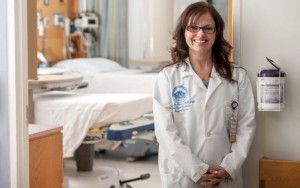
April 7th, 2017 by Dr. Val Jones in Opinion
Tags: Costs, DocTalker, eDocAmerica, Health Insurance, HSA, Outpatient Medicine, Telehealth, Telemedicine
1 Comment »
 Over 1 million virtual doctor visits were reported in 2015. Telehealth companies have long asserted that increased access to physicians via video or phone conferencing saves money by reducing office visits and Emergency Department care. But a new study calls this cost savings into question. Increased convenience can increase utilization, which may improve access, but not reduce costs.
Over 1 million virtual doctor visits were reported in 2015. Telehealth companies have long asserted that increased access to physicians via video or phone conferencing saves money by reducing office visits and Emergency Department care. But a new study calls this cost savings into question. Increased convenience can increase utilization, which may improve access, but not reduce costs.
The study has some obvious limitations. First of all, it followed patients who used one particular telehealth service for one specific cluster of disease (“respiratory illness”) and narrowed the cost measure to spending on that condition only. Strep throat, coughs, and sinusitis are not drivers of potentially expensive care to begin with, so major cost savings (by avoiding the ER or hospitalization) would not be expected with the use of telehealth services for most of these concerns.
Secondly, the patients whose data were scrutinized had commercial insurance (i.e. a generally healthier and younger population than Medicare beneficiaries, for example), and it is possible that the use of telehealth would differ among people with government insurance, high-deductible plans or no insurance at all.
Thirdly, the study did not look at different ways that virtual doctor visits are currently being incorporated into healthcare delivery systems. For example, I was part of a direct primary care practice in Virginia (DocTalker Family Medicine) that offered virtual visits for those patients who had previously been examined in-person by their physician. The familiarity significantly reduced liability concerns and the tendency for over-testing. Since the doctor on the other side of the phone or video knew the patient, the differential diagnosis shrank dramatically, allowing for personalized real-time treatment options.
I’ve also been answering questions for eDocAmerica for over 10 years. This service offers employers a very low cost “per member per month” rate to provide access to board-certified physicians who answer patient questions 24/7 via email. eDocs do not treat patients (no ordering of tests or writing prescriptions), but can provide sound suggestions for next steps, second opinions, clarifying guidance on test results, and identify “red flag” symptoms that likely require urgent attention.
For telehealth applications outside the direct influence of health insurance (such as DocTalker and eDocAmerica), cost savings are being reaped directly by patients and employers. The average DocTalker patient saves thousands a year on health insurance premiums (purchasing high deductible, catastrophic plans) and using health savings account (HSA) funds for their primary care needs. They might spend $300/year on office or virtual visits and low-cost lab and radiology testing (pre-negotiated by DocTalker with local vendors). As for eDocAmerica, employers pay less than a dollar per month for their employees to have unlimited access to physician-driven information.
The universe of telehealth applications is larger than we think (including mobile health, remote patient monitoring, and asynchronous data sharing), and already extends outside of the traditional commercial health insurance model. Technology and market demand are fueling a revolution in how we access outpatient healthcare (which represents ~40% of total healthcare costs), making it more convenient and affordable. As these solutions become more commonplace, I have hope that we can indeed dramatically reduce costs and improve access to basic care.
Keeping people well and out of the hospital should be healthcare’s prime directive. When those efforts fail, safety net strategies are necessary to protect patients from devastating costs. How best to provide that medical safety net is one of the greatest dilemmas of our time. For now, we may have to settle for solving the “lower hanging fruit” of outpatient medicine, beginning with expanding innovative uses of telehealth services.
April 5th, 2017 by Dr. Val Jones in Health Tips, Opinion
Tags: Cancer Rehab, Oncology, Physiatry, PM&R, Rehabilitating From Cancer, Rehabilitation Medicine
1 Comment »
This blog post first appeared at: Curious Dr. George
 Rehabilitation medicine is one of the best-kept secrets in healthcare. Although the specialty is as old as America’s Civil War, few people are familiar with its history and purpose. Born out of compassion for wounded soldiers in desperate need of societal re-entry and meaningful employment, “physical reconstruction” programs were developed to provide everything from adaptive equipment to family training, labor alternatives and psychological support for veterans.
Rehabilitation medicine is one of the best-kept secrets in healthcare. Although the specialty is as old as America’s Civil War, few people are familiar with its history and purpose. Born out of compassion for wounded soldiers in desperate need of societal re-entry and meaningful employment, “physical reconstruction” programs were developed to provide everything from adaptive equipment to family training, labor alternatives and psychological support for veterans.
Physical medicine and rehabilitation (PM&R) then expanded to meet the needs of those injured in World Wars I & II, followed closely by children disabled by the polio epidemic. In time, people recognized that a broad swath of diseases and traumatic injuries required focused medical and physical therapy to achieve optimal long term function. Today, cancer patients frequently benefit from comprehensive rehabilitation as they recover from the effects of chemo (neuropathy, weakness, and cognitive impairments), radiation (scarring and range of motion limitations), surgery (flaps, plastics procedures, tumor resection, amputations), and brain injuries (edema, debulking, gamma knife and neurosurgery).
Rehabilitation is a phase of recovery occurring after any major life-changing medical or surgical event. Our bodies are designed to regenerate and repair, though optimizing this process takes skilled guidance. PM&R physicians (also known as physiatrists) are trained to use physical modalities (stretching, strengthening, heat, cold, etc.) to mechanically enhance healing. They prescribe medications to manage pain, spasticity, nerve injury, and cognitive impairments, while also leveraging the power of physical therapy to increase cardiopulmonary fitness, muscle strength and flexibility. PM&R physicians are also experts in neurologic injury, and can adapt exercises to coax spinal cord, brain and peripheral nerve injuries to construct new pathways for movement and repair.
Inpatient rehab’s prime directive is to get patients back home. To succeed at home, patients need to be able to function as independently as possible, using trained assistants for managing the activities that cannot be performed without help. Admission to a rehab hospital or unit offers the patient home practice opportunities – with simulated challenges that can include everything from terrain parks, test kitchens, medication management trials, driving simulators, balance tests, electric wheelchairs and even exoskeletons that allow paralyzed patients to walk again. It is like a robotic Disney World, with endless aquatic and equipment possibilities for restoring movement and independence.
When I discuss admission to inpatient rehab with my cancer patients, I ask them about their goals, motivation, and energy levels. Timing of rehab is important, because it must dovetail with treatment, so that the physical exertion strengthens, not saps, the patient. Often times when a person is newly diagnosed with cancer, they want “everything done” – intensive chemo/radiation/surgery as well as rehab/exercise. But staggering these interventions can be more effective.
In other cases when care is palliative, learning new skills and being fitted with battery or electric-powered equipment can mean the difference between living at home or in an assisted environment. Some successful cancer patients come to inpatient rehab to practice managing their activities of daily living with varied amounts of assistance, preparing for increased needs as time goes on so they can enjoy being at home for as long as possible.
For the physiatrist, cancer is a cause of impairments that can be overcome with creativity and practice, no matter the long-term prognosis. Adaptive equipment, physical exercise, and cognitive retraining may be applied intensively (3 hours a day in the inpatient setting), or at a slower outpatient pace, depending on individual need. Rehab physicians desire to support and sustain patient function at the highest level, and “add life to years.” As such, rehabilitation should be considered an integral part of successful cancer care and management.
June 27th, 2016 by Dr. Val Jones in Health Policy, Opinion
Tags: Arthritis, Charity Care, Costs, Coverage, Low Reimbursement, medicaid, Obamacare, Orthopedic Surgery
1 Comment »
 Most hospitals have slim margins, and budgets are set based on anticipated average patient reimbursement at Medicare rates. Some private insurers pay higher rates than Medicare, and the differential is often used to offset the cost of treating Medicaid patients. Medicaid reimburses at about half what Medicare pays, which is usually not enough to break even. Out of financial necessity, Medicaid patients are often given limited access to care and services. This is done in some subtle and some not-so-subtle ways. In a recent conversation with an orthopedist friend of mine, he confided in me candidly:
Most hospitals have slim margins, and budgets are set based on anticipated average patient reimbursement at Medicare rates. Some private insurers pay higher rates than Medicare, and the differential is often used to offset the cost of treating Medicaid patients. Medicaid reimburses at about half what Medicare pays, which is usually not enough to break even. Out of financial necessity, Medicaid patients are often given limited access to care and services. This is done in some subtle and some not-so-subtle ways. In a recent conversation with an orthopedist friend of mine, he confided in me candidly:
“Some of my colleagues in private practice can’t pay their office overhead if they treat Medicaid patients. So we see poor people with severely arthritic joints left in pain at home. In addition, with bundled payments, the surgeon gets a fixed amount for the patient’s operation and recovery. What incentive is there to send the patient to a rehab facility? It just takes money away from the surgeon. So the poor have to suffer with very long wait times to see someone who will operate on them, and then afterwards they’re on their own for recovery. Patients who go straight home are at higher risk of falling and may have much poorer outcomes. Surgeons get financial incentives for good outcomes, so it becomes a double disincentive to treat Medicaid patients. You don’t get enough for the operation, and you’re likely to get penalized for their poorer outcomes. Some surgeons I know wont touch a patient with Medicaid for any elective procedure. I have ethical problems with that – so I work at a non-profit hospital where we treat everyone. But I have to do higher volume to break even. I work 90 hours a week and barely see my family. I don’t know how much longer I can do it.”
It is common practice among nursing homes to have a limited number of “Medicaid beds.” The facility simply declines to admit more than 20% of patients with Medicaid. I hear case managers on the phone all day long, looking for a post-acute care facility who will accept a Medicaid patient. For the few non-profit facilities who don’t turn them away, deep financial costs are incurred as they struggle for survival.
The reality is that Medicaid rates are so low that having this insurance is not much better than none at all. As I’ve explained previously in the outpatient world (see an example of an insanely low Medicaid reimbursement for eye care), Medicaid is tantamount to charity care. The news that 21.3 million Americans might receive Medicaid coverage in the next decade should not be hailed as a leap forward. As I see it, that’s just a larger group of people with debilitating arthritis who can’t get hip and knee replacements and are left to suffer in pain at home.
May 16th, 2016 by Dr. Val Jones in Opinion
Tags: First Job Out Of Residency, Hospital Career, How To Choose, Job satisfaction, Locum Tenens, Traveling Physician, Try Before You Buy, Work
No Comments »
 *This blog post was initially published on the Barton Blog.
*This blog post was initially published on the Barton Blog.
When doctors complete their residency training, they are under a lot of pressure to land their first “real job” quickly. Student loan deferments end shortly after training, and whopping debt faces many of them. But choosing a job that is a good long-term fit can be difficult, and gaining a broader exposure to the wide variety of options is key to success. That’s why “try before you buy” can be an excellent strategy for young physicians.
Locum tenens agencies such as Barton Associates work with healthcare organizations and practice locations across the country to offer a variety of temporary assignments for physicians.
These agencies negotiate your salary and call schedule. They also arrange the logistics, covering the costs of travel and accommodations. Once the doctor and the facility agree to terms, the physician simply arrives on the required date(s) and takes on the responsibilities requested. It’s a hassle-free, minimal-commitment arrangement that pays an hourly or daily rate for work.
Locum providers are given the convenient option to receive direct deposits to their bank accounts at regular intervals. Physicians can travel as broadly as they like for assignments, and the agency credentialing team works to efficiently complete any needed paperwork for new licenses and hospital privileging.
I enjoyed “living la vida locum” for six years before I landed my dream job. That’s a long time to be living out of a suitcase, and I doubt that most of my peers would want to do it for that long of a stretch. But an amazing thing happened during those years: With each new hospital experience, I gained insight and knowledge about my specialty. By rubbing elbows and networking with a wide swath of patients and experts across the country, I became a sought-after consultant in my own right.
I experienced different ways of delivering healthcare — from critical access hospitals to bustling academic centers. I learned about best practices and creative solutions that administrators and clinical staff had discovered to improve care quality, given the limitations of Medicare rules and private insurance restrictions.
When I was hired as the Medical Director of Admissions at St. Luke’s Rehabilitation Institute in Spokane, Washington, I came armed with creative ideas and a wealth of experience to draw from. I was a highly seasoned physician who had been exposed to the widest variety of patient populations and practice styles. I knew all about the unique struggles, successes, and solutions of various rehab centers across America. I now leverage that experience to drive change at my institution, and I am virtually unfazed by new problems and challenges.
The career value of locum tenens work is extraordinary. Take the time to look around you at each assignment. Learn what works and what doesn’t work, and file it away for future reference.
Like a bumblebee cross-pollinating hospital or medical practice “flowers,” locum tenens providers have the potential to drive change like no one else. When you’ve seen it all, your insights become invaluable, and you gain the maturity to know when a full-time job is the right cultural fit. Choosing the right job, on your terms and in your time, is the key to finding happiness in healthcare.
February 20th, 2016 by Dr. Val Jones in Opinion
Tags: False Hope, healthcare, Hope, Keeping Hope Alive, Rehabilitation Medicine, What Doctors Say
6 Comments »
 Hope is a tricky thing. On the one hand, false hope can lead patients to opt for painful, futile treatments at the end of life. On the other, unnecessarily bleak outlooks can lead to depression and inaction. When health is at stake, presenting information with the right amount of hope can guide patients away from both suffering needlessly and/or succumbing to treatable disease.
Hope is a tricky thing. On the one hand, false hope can lead patients to opt for painful, futile treatments at the end of life. On the other, unnecessarily bleak outlooks can lead to depression and inaction. When health is at stake, presenting information with the right amount of hope can guide patients away from both suffering needlessly and/or succumbing to treatable disease.
I was reading a sad story about a patient whose physician had made her feel hopeless. She was an elderly widow with some real, but not immediately life-threatening, medical conditions. His attitude led her to believe that she was sick and useless – with little to look forward to but ongoing testing, disease progression and eventual death. His professional opinion held special weight for her, coloring her entire outlook. It wasn’t until a friend reminded her of the doctor’s fallibility that she began to question her diagnoses, treatment options, and even prognosis.
When faced with concerning new medical diagnoses, even the most educated among us tend to imagine the worst case scenario. Knowing this, physicians should take care to offer reassurance and optimism whenever it is warranted. Hope provides the energy to course correct, to fight battles that can be won, and to hold on to trust in a brighter future. Why be stingy with it when it is so easily given?
As a rehab physician I have regularly encountered bias on the part of healthy people in regards to certain injuries. I hear them whisper, “I wouldn’t want to go on living if I couldn’t walk” or “That poor man’s life must be ruined.” And yet, these feelings are not shared by those fighting the battles. In many cases, losing an ability focuses the mind on what’s important – and on all the things that can still be achieved and enjoyed. Life is a gift, and while we all still have breath – we can make meaningful contributions.
It breaks my heart to see patients lose hope, and it is sadder still when physicians facilitate the loss. What we say carries psychological weight, and we should recognize the duty we have to deliver information with kindness and respect – focusing on the possible, dispelling unreasonable fears, and emphasizing that inner peace is attainable no matter the circumstance.
In healthcare we ought to always have hope – not for perfect health, or longer life – but in our ability to overcome obstacles, to make good come from bad, and to have a positive impact on others. The choice to live our best life is ours to make, no matter the disease or condition. Never let a doctor steal your hope, but adopt the rehab mission: to add life to years.
 Over 1 million virtual doctor visits were reported in 2015. Telehealth companies have long asserted that increased access to physicians via video or phone conferencing saves money by reducing office visits and Emergency Department care. But a new study calls this cost savings into question. Increased convenience can increase utilization, which may improve access, but not reduce costs.
Over 1 million virtual doctor visits were reported in 2015. Telehealth companies have long asserted that increased access to physicians via video or phone conferencing saves money by reducing office visits and Emergency Department care. But a new study calls this cost savings into question. Increased convenience can increase utilization, which may improve access, but not reduce costs.


 Rehabilitation medicine is one of the best-kept secrets in healthcare. Although the specialty is as old as America’s Civil War, few people are familiar with its history and purpose. Born out of compassion for wounded soldiers in desperate need of societal re-entry and meaningful employment, “physical reconstruction” programs were developed to provide everything from adaptive equipment to family training, labor alternatives and psychological support for veterans.
Rehabilitation medicine is one of the best-kept secrets in healthcare. Although the specialty is as old as America’s Civil War, few people are familiar with its history and purpose. Born out of compassion for wounded soldiers in desperate need of societal re-entry and meaningful employment, “physical reconstruction” programs were developed to provide everything from adaptive equipment to family training, labor alternatives and psychological support for veterans. Most hospitals have slim margins, and budgets are set based on anticipated average patient reimbursement at Medicare rates. Some private insurers pay higher rates than Medicare, and the differential is often used to offset the cost of treating Medicaid patients. Medicaid reimburses at about half what Medicare pays, which is usually not enough to break even. Out of financial necessity, Medicaid patients are often given limited access to care and services. This is done in some subtle and some not-so-subtle ways. In a recent conversation with an orthopedist friend of mine, he confided in me candidly:
Most hospitals have slim margins, and budgets are set based on anticipated average patient reimbursement at Medicare rates. Some private insurers pay higher rates than Medicare, and the differential is often used to offset the cost of treating Medicaid patients. Medicaid reimburses at about half what Medicare pays, which is usually not enough to break even. Out of financial necessity, Medicaid patients are often given limited access to care and services. This is done in some subtle and some not-so-subtle ways. In a recent conversation with an orthopedist friend of mine, he confided in me candidly: *This blog post was initially published on the
*This blog post was initially published on the  Hope is a tricky thing. On the one hand, false hope can lead patients to opt for painful, futile treatments at the end of life. On the other, unnecessarily bleak outlooks can lead to depression and inaction. When health is at stake, presenting information with the right amount of hope can guide patients away from both suffering needlessly and/or succumbing to treatable disease.
Hope is a tricky thing. On the one hand, false hope can lead patients to opt for painful, futile treatments at the end of life. On the other, unnecessarily bleak outlooks can lead to depression and inaction. When health is at stake, presenting information with the right amount of hope can guide patients away from both suffering needlessly and/or succumbing to treatable disease.







